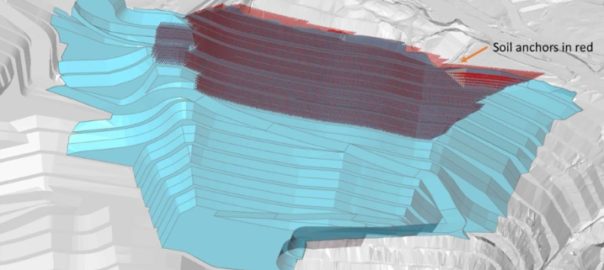The Newcrest Mining Board has approved the Lihir Phase 14A feasibility study, endorsing the Papua New Guinea project into full implementation.
As part of the study, site investigation and trial works have been completed and a plan has been developed which extends the Phase 14 cutback and safely steepens the walls of the pit using civil engineering techniques, the company says.
Completion of a drilling program has significantly improved the geotechnical knowledge of the cutback area and enabled refinement of the anchor design and placement to better suit the geotechnical conditions.
Ground anchors will be installed in the upper benches of the cutback to support the steeper wall angles in these areas. The slope angles of the lower benches will be similar to the existing walls in Phase 14. The upper Argillic horizons without ground support typically have an unsupported slope angle of circa-45°, which has been increased to circa-68° using ground anchors. The improved geotechnical knowledge has enabled the study design to reduce slope angles from circa-77% in the prefeasibility study while improving overall stability.
The study outlined a project with estimated total capital expenditure on a real basis of circa-$280 million and a nominal basis of circa-$296 million. For this, the company is looking at circa-400,000 oz/y of incremental Phase 14A gold output from the 2023-20226 financial years. On a life of mine basis, this incremental production would increase to circa-800,000 oz/y.
Newcrest Interim Chief Executive Officer, Sherry Duhe, said: “The development of Phase 14A is another innovative step forward in realising the full potential of Lihir. The findings of the study are expected to deliver gold production from an additional high-grade ore source which would have otherwise been inaccessible through standard mining techniques.
“The study outlines an updated life of mine plan, with upside potential. The application of steep wall technologies, together with an alternative, lower cost and simpler seepage barrier design have the potential to enable access to additional high-grade zones outside the current ore reserve and extend the elevated production profile beyond the 2031 financial year.
“Our team continues to work diligently to maintain a strong focus on capital discipline, placing several recovery improvement capital projects on hold that currently do not meet our investment criteria. The Phase 14A ore zone is now well informed by geotechnical drilling that underpins the design and stability of the cutback, and we expect Phase 14A to be delivering higher-grade ore from financial year 2024.”
Through an early works program, mining of Phase 14A commenced in the June 2022 quarter and will continue through to the 2027 financial year. Ore mined from Phase 14A will displace lower-grade ore feed to the processing plant, with circa-13 Mt of high- and medium-grade ore from Phase 14A expected to be fed through to the 2026 financial year to produce that incremental circa-400,000 oz of gold. Lower grade material will be stockpiled and fed progressively over the remaining mine life.
The Lihir gold production schedule forecasts mining rates to increase up to 55 Mt/y over the coming years. Ore from Phase 14A is expected to be mined between the 2022 financial year and the 2027 financial year with high-grade ore fed directly to the mill while the lower-grade ore will be processed over the life of mine.
Mining rates for Lihir are expected to continue to increase over the coming years through a combination of equipment capacity and mining efficiency projects. Additional mining capacity has been delivered following a program of truck re-builds and the replacement of primary dig units completed in the 2022 financial year. In combination with a “maintenance excellence program”, mechanical availability has increased to 84% from 79% over the last 12 months, Newcrest said.
Mine efficiency improvements identified in the most recent study have also been realised including improved fleet utilisation and effective dispatch tactics to reduce equipment delays. Open-pit productivity continues to advance with Lihir delivering strong improvement in ex-pit movements during 2022.
Further application of the civil steep slope technology used in Phase 14A is being assessed to potentially unlock additional high-grade mineralisation outside the current ore reserve in the northern and eastern extents of the Kapit orebody, Newcrest says. This work has the potential to improve the production profile beyond the 2031 financial year, before the high-grade ore from Kapit declines. The design optimisation and associated impact on the longer-term production profile is expected to be completed in the second half of 2023.
“In addition, following completion of the Seepage Barrier Feasibility Study in October 2021, an alternative seepage barrier design, the Nearshore Soil Barrier (NSB) option, is currently being studied,” the company said. “The NSB would sit between the No Coffer Dam limit and the existing shoreline of the Inner Harbour, approximately 500 m west of the proposed Kapit Seepage Barrier (KSB).
“Initial work indicates that the NSB would be a simpler solution, faster to construct and less costly. A prefeasibility study (PFS) level assessment of the NSB option is currently underway and is expected to be completed in 2023.”
Newcrest said the study production profile has been updated, with mill throughput rates revised to incorporate increased ore hardness based on an improved geometallurgical understanding. Mill operating time has been revised to reflect current mill performance with a more progressive ramp up in improvement. Options to increase throughput rates continue to be assessed going forward. Recovery assumptions have also been adjusted, with several recovery improvement capital projects no longer meeting Newcrest’s investment criteria following the inclusion of cost inflation pressures into estimates. These projects have been placed on hold and will continue to be assessed for potential inclusion into the mine plan at a later date, it said.







